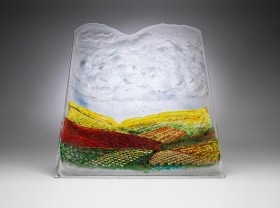The adoption of eBooks is changing not only our reading habits but also the look of our homes and the material objects that dominate our visual environment. Once overflowing bookshelves are now left dusty and forgotten as a single eReader sits smugly on the coffee table. The visible presence of books in the home is diminishing and this physical loss may be profound on those that value the tangible.
While some readers have taken sides as advocates of digital or defenders of print, many are now negotiating a balance between different platforms, recognising that books are more than just vehicles to read but also visual objects which celebrate and souvenir our reading.
The world’s biggest virtual bookstore Amazon will go to market next week with a new service which recognises that for many eBooks are not enough. MatchBook is a book bundling service that offers the digital counterparts of print publications to customers who buy print publications for only three dollars a title, or less.
The service is retroactive, so customers who bought a print publication from Amazon any time since its inception in 1995 are eligible for the discount digital rate.
While for Amazon the service may be a way of seducing the traditional print reader into trying digital, it also acknowledges that print continues to have appeal. MatchBook demands a new kind of thinking about whether digital, print or both is preferable for a given title.
The advantage may be with eBooks in convenience, portability and price but what about the other purposes books serve: as literary artefacts or an art form in their own right? With the growing prevalence of eBooks, is there may be a growing market for literary artefacts that offers opportunities to designers and visual artists.
Books for display
By bowing to the convenience of digital, the physicality of print publications has been traded away. Directly addressing this loss of physical representation, a ‘books for display’ trend has arisen.
People are reading eBooks, and if they enjoy them, purchasing the print version for home display. The bookshelf has become a trophy cabinet, filled with pristine books that have never been read.
Mark Coker is founder of Smashwords, an eBook publishing and distribution platform that has worked with more than 200,000 titles. Coker characterises displaying books as a form of self-expression. ‘Just like with any form of media that touches our soul and brings pleasure through entertainment or knowledge, I think there will always be demand for physical representations of that passion.’
Branding and merchandising
Michelle Calligaro, Digital Manager of Text Publishing, is unsure whether a further representational product is needed. She finds devices that try and physicalise the digital, such as electronic photo frames, questionable at best.
When asked about possible future markets for eBook souvenirs Calligaro uses current market trends to inform her predictions. ‘Obviously the physical book and the idea of bundling I think is a big thing – that’s what I think would be the most likely. Other than that I suppose it would be branding.’
Merchandising, of course, has long been a force in children’s publishing where toys and games supplement the book. In recent years many publishers have dabbled in adult merchandising, none so effectively as the Penguin brand, which has its own collection that includes notebooks, tote bags, book bags, mugs, tea towels, and other day to day items.
As digital publications continue to mainstream, revenue may be increasingly pumped into merchandising across publishing houses, popular authors, and literary genres, with readers prepared to buy products to replace book covers.
Fandom
Another physical manifestation of eLiterature may rest in the fangirl and fanboy world of collectibles. Darrell Pitt, author of The Last Days of Earth, The Steampunk Detective, and the Diary of a Teenage Superhero series, available digitally through Amazon, creates teen fiction, action, fantasy and science fiction works.
Pitt is often sent fan requests for physical signed souvenirs relating to his stories. ‘I’ve had a number of emails requests for signed mementos and I’ve sent off A4/A3 posters that I’ve signed,’ said Pitt. He has also seen some authors navigating the digital by producing postcards that have their book cover on them to sign.
When asked for more examples of fandom, Pitt considers the convention circuit trend where people buy pictures of actors to be signed. However, he believes signed posters and postcards remain as the norm for authors. ‘I don’t think people will want a signed picture of me or other writers. (I hope not – I don’t have a good side!),’ said Pitt.
Homemade t-shirts and costumes that pay tribute to favourite books in order to celebrate their literary love is a regular occurrence, and signings on digital eReaders in permanent marker is also a common sight. While this is largely a DIY culture, it shows a desire to be surrounded with physical manifestations of popular reads, and may inform a future commercial market.
Digital souvenirs
With the future offering an increase of digital opportunity through expanding electronic platforms and technological capabilities, the balance between electronic and real world books is likely to tip towards the digital. Perhaps the souvenirs too will become part of the virtual world: images, tokens or illustrations that can be accessed on a tablet or displayed on a screen.
Already there is Autography, a technoloy that allows eBook authors to digitally sign eBooks.
‘Although I think a desire for the physical object will persist, I think we’ll start seeing more of this self-expression manifested with digital objects, said Coker. ‘It’s only limited by the power of the story, and the power of the artist’s imagination and interpretation of that story,’ said Coker.
Digital-real world hybrids may also appear, such as a series of objects embedded with functional electronics; for example, collectable tokens that can trigger a book to be opened in a more tactile and gamer inspired way (think Skylanders figurines that interact with the video game).
A collection of these artefacts lifted from various stories may make the home a museum of mixed narratives, just as a bookshelf has been.
Perhaps the electronic world will take on real world values and contribute to a modern understanding of tangibility. This could cancel out the need for any real world representation of literature.
The unknowns are many but the opportunities are tremendous, said Pitt. ‘The whole marketplace has been turned upside down and it hasn’t finished yet. Nobody knows what’s next. All I know is that this is the best time for writers that has ever existed and I’m glad I’m around for it.’





